Bring on the butterflies, moths,
and, of course, the bees!
I can’t hide my penchant for pollinators.
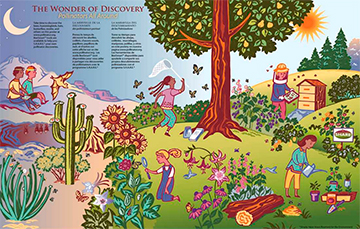
“The Wonder of Discovery: Pollinators All Around” by Carolyn Vibbert
It’s that time of year …
Blooms are bursting open around the farm, spiffing up the place with color and fragrance. I welcome the annual buzz and whir of those wondrous little magicians who make food happen. Last weekend, I was showing my grandgirls some flowers that were covered in our honeybees. I explained how it all ended up as honey, but more important, I explained that without the bees buzzing around the flowers on our blueberry bushes, we wouldn’t get blueberries. (Blueberries are Mia’s favorite food.)
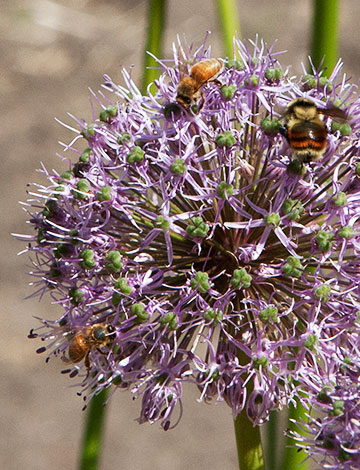
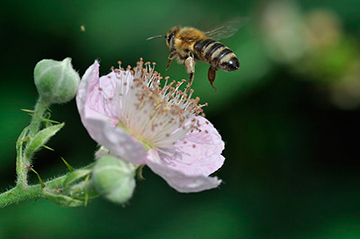
Photo by Aiwok via Wikimedia Commons
Six years ago, the U.S. Senate unanimously declared the third week in June as “National Pollinator Week” to help address the declining pollinator crisis, and Pollinator Week has blossomed into an international celebration.
This year, the party kicks off on June 17, and the Pollinator Partnership website offers ideas about how you can get involved.
For my part, I’m focusing on some of my garden’s most charming guests:
hummingbirds.
A little Rusty-breasted Rufous gal paused to peek into my window this morning, then she rocketed away toward the garden.
But I knew she would end up landing here in my journal …
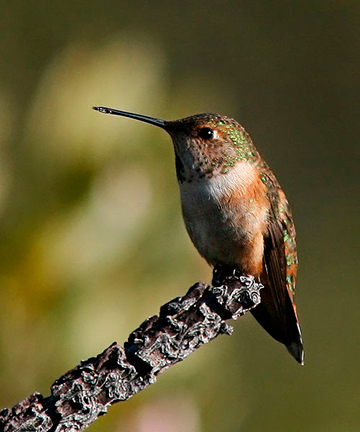
Photo by Sberardi, via Wikimedia Commons
Nature’s Nectar
As fun as it is to watch hummers flock to a feeder, it warms my heart all the more to see them sipping nectar as nature intended:
from flowers.
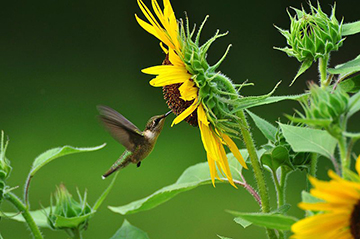
Photo by jeffreyw via Wikimedia Commons
Planting native vegetation is the key to attracting wildlife (like hummingbirds) with the least amount of effort. Once established, native plants don’t require fertilizers, herbicides, or pesticides, which can be harmful to hummers.
According to Portland Nursery over in Oregon, Northwestern gardeners like me can offer an enticing buffet of native flowers to attract hummingbirds from early spring to fall. Take a look at their recommendations here.
Since hummingbirds don’t have a keen sense of smell, they rely on bright colors to find their food, and red is their all-time favorite.
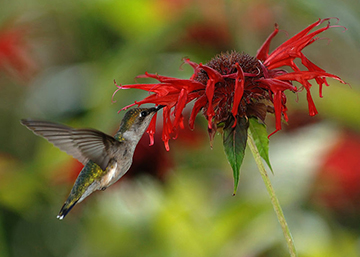
Photo by Joe Schneid via Wikimedia Commons
Feeder Feast
If you have limited flower space or simply enjoy treating hummers to an easy feast from a feeder, skip the store-bought nectar, which is expensive and may contain artificial ingredients, and use this simple recipe to make your own.
You’ll Need:
- 1 cup organic sugar (a 10-pound bag of Wholesome Sweeteners Fair Trade Organic Sugar sells for $30 on Amazon)
- 4 cups water
- Mix sugar and water in a saucepan and boil for two minutes (no microwaving—it breaks down the sugar molecules and makes the nectar unfit for bird consumption … hmmmmmmm). Cool the mixture and fill your feeder. Unused nectar can be stored in the refrigerator for up to two weeks.
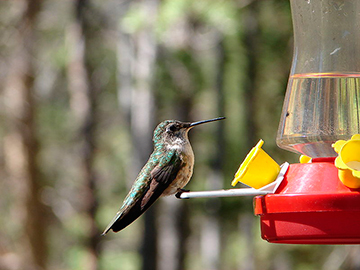
Photo by Michelle Lynn Reynolds via Wikimedia Commons
A few more feeder tips to keep in mind:
- Use only real sugar for your nectar. It has been found to mimic flower nectar very well and provides hummingbirds with the energy they need. Honey can actually kill hummingbirds by causing a tongue disease.
- Contrary to popular practice, it is not a good idea to use red food coloring in your mixture. The red plastic “blooms” of the feeder are all you need to lure in the birds.
- Change your hummingbird nectar every 3-5 days (every 2 days in hot weather or direct sunlight) to avoid fermentation, which turns the nectar cloudy and sour.
- Clean the feeder with hot water every time you change the nectar. If the feeders get gross, submerge them in boiling water for five minutes.
Oh, and if you haven’t read my post on hummingbird whispering, feast your eyes here.













































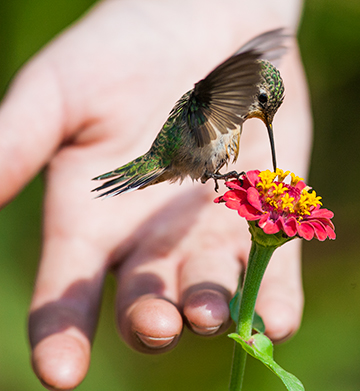








I’m so thankful you shared this topic with us today. Not only do I love our pollinators (and so appreciate & enjoy the topic) but it also enabled me to see the date of my first post here on your, Raising Jane Website. You lured me in immediately on my very first look at your site; on that particular day when you shared the wonderful pictorial of the “Hummingbird Whisperer” & the rest is history!
I was outside deadheading this morning & noticed two different hummingbirds in our garden. One of our female hummers was pregnant last month & I suspect has already laid her eggs but I believe she could be pregnant again & building another nest? Just a couple days ago our Verbascum started to bloom (this is the fantastically fluffy~cotton producing~Lambs Ear like Verbascum). Two days ago, I was sitting outdoors enjoying/studying/watching all things garden related when one of the hummingbirds flies into the fluff of flaking cotton verbascum & plucks a few cotton puffs off here & there & then flies away into the trees. The hummingbird would do this again 3 more times, all within minutes of her last verbascum plucking.
I’ve also been fortunate to see hummingbirds fly into our spider webs & grab pieces & carry them off. Just last year I witnessed a hummingbird fly onto the bark of our Maple tree & pluck something off or lick some sap? I was so excited because I had read that hummingbirds will eat sap in early Spring & was so hopeful that this little flying graceful gem was eating sap. But when I walked over to look at the maple I didn’t see any sap oozing out…& I didn’t notice any woodpecker marks?
It is an amazing & truly graced moment when you get to see a hummingbird/s thriving in your garden.
We have found that the flowers called Pintas, which come in red, magenta, and a pink are the best attractors for our hummingbirds locally. Nothing else works as well in our yard so we have lots of pots of various colors and enjoy the show!
Looking forward to the arrival of the hummingbirds in the spring is an annual ritual at my home. The homemade nectar is easy to make (It even makes a dandy base for a mint julep for we humans!). The hummies usually arrive about a week before the Kentucky Derby is run. I make it a habit of toasting their arrival with a mint julep!